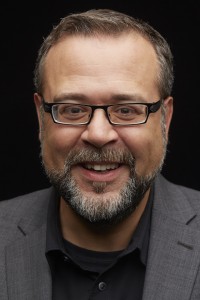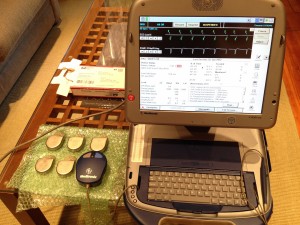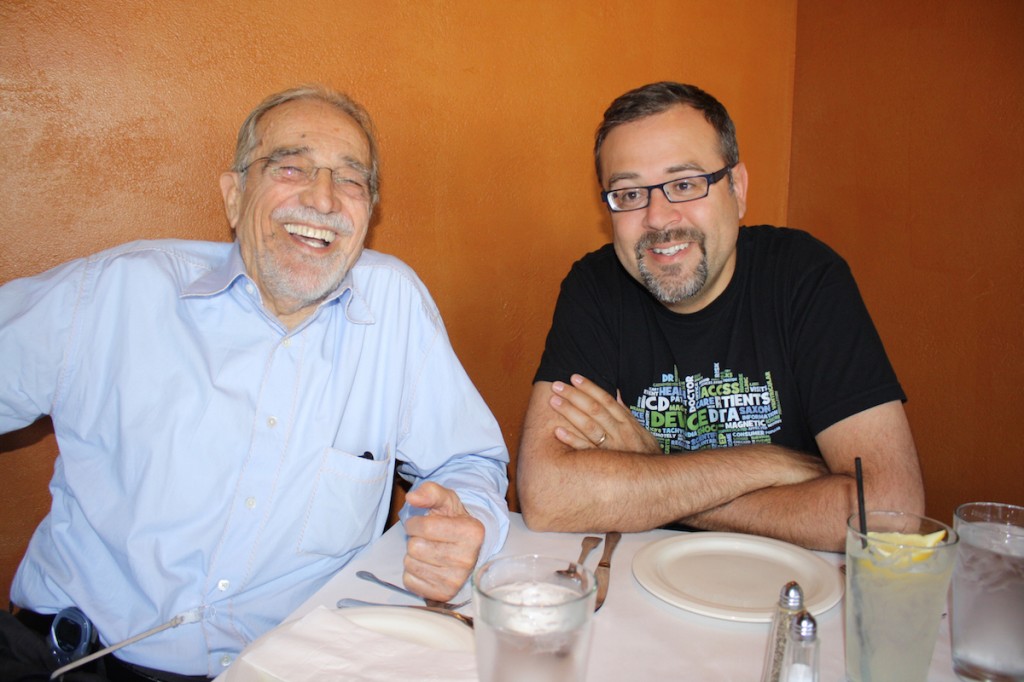My Device, My Body, My Data
Ernesto Ramirez
February 4, 2015
In 2007, after collapsing while rushing to board a train, Hugo Campos was diagnosed with hypertrophic cardiomyopathy, and an ICD (implantable cardioverter defibrillator) was implanted in his chest to track and regulate his heart rhythm. To his great surprise, he discovered that it was very difficult to gain access to the data being generated inside his own body. Today we’re inaugurating what we hope will be a regular series of “QS Conversations” about data access with an interview with Hugo about his long battle for the right to see what’s happening inside himself.
Ernesto: Why does access to your ICD data seem so important to you?
 Hugo: I have a computer with firmware, processor and memory regulating my every heartbeat, wired into my heart, and buried inside my body. I can’t even see it. A corporation in the cloud, located out of state, has a wireless, transparent access to a device that’s implanted in my body, but the only control I have is to unplug the remote monitoring unit in my house to prevent them from getting the data. This creates a very unsettling feeling of not having autonomy. I’m paying thirty thousand dollars for a device, having it implanted inside my body, and then being locked out of it.
Hugo: I have a computer with firmware, processor and memory regulating my every heartbeat, wired into my heart, and buried inside my body. I can’t even see it. A corporation in the cloud, located out of state, has a wireless, transparent access to a device that’s implanted in my body, but the only control I have is to unplug the remote monitoring unit in my house to prevent them from getting the data. This creates a very unsettling feeling of not having autonomy. I’m paying thirty thousand dollars for a device, having it implanted inside my body, and then being locked out of it.
Ernesto: Was there something that happened that set you on this path?
Hugo: Yes. For a long time I’d been on my spouse’s health care plan, but when he decided to freelance and quit his job, I couldn’t get health insurance. This was before the Patient Protection and Affordable Care Act. Kaiser denied me because I had a heart condition. Anthem Blue Cross denied me as well. Now put yourself in my shoes. Here I am, being denied access to the device because the system “knows better” and I could harm myself, but now they can’t give me service at all.
Ernesto: You can only get access to your ICD through the medical system, but the medical system won’t take you because you have an ICD?
 Hugo: Right, so I had to figure out a way to protect myself. I looked at it as kind of an extension of my Second Amendment rights. I’m not particularly pro-gun, but I look at it as the ability to defend myself. If the system was really unavailable, I have to at least be able to interrogate my ICD. So, I went on eBay and bought a pacemaker programmer that gave me full, unrestricted access to my implanted device. I can change its programming, shut it off, deliver therapy, and do as I wish. In fact, it’s the same machine that clinics use. I also went to Greenville, South Carolina, and took a class on how to program ICDs and pacemakers. I thought, “Okay, I may not become a cardiac electrophysiologist by any stretch of imagination, but”–to use the firearm metaphor again–”at least I have a basic understanding of gun safety so I don’t shoot myself.”
Hugo: Right, so I had to figure out a way to protect myself. I looked at it as kind of an extension of my Second Amendment rights. I’m not particularly pro-gun, but I look at it as the ability to defend myself. If the system was really unavailable, I have to at least be able to interrogate my ICD. So, I went on eBay and bought a pacemaker programmer that gave me full, unrestricted access to my implanted device. I can change its programming, shut it off, deliver therapy, and do as I wish. In fact, it’s the same machine that clinics use. I also went to Greenville, South Carolina, and took a class on how to program ICDs and pacemakers. I thought, “Okay, I may not become a cardiac electrophysiologist by any stretch of imagination, but”–to use the firearm metaphor again–”at least I have a basic understanding of gun safety so I don’t shoot myself.”
Ernesto Ramirez: Are you an “engaged patient”?
Hugo: I don’t care about patient engagement. Patient engagement is important for everyone but the patient. It’s important to the doctors, providers, payers, and government regulators. A hospital administrator who wants to engage patients is probably thinking about filling beds or getting people to use his hospital for their cardiac surgery. A researcher might be looking to improve health outcomes or be published. A payer is looking for other things. Their goals may be cynical or altruistic, but, in any case, they’re not really the same goals that patients have. But the kind of engagement that patients want is with our families and friends.
Ernesto: Engagement tends to mean engagement with the health care system, not autonomy, and not self-care.
Hugo: Right. Now, that my dad has been living with us, the importance of autonomy is even clearer to me. My dad has congestive heart failure. One day, his feet were swollen, and I thought, “Should he take an extra Lasix, a diuretic?” But we can’t even get his physician or his primary care provider on the phone. It’s impossible. The way to communicate with her is by fax. I have to type something that is coherent and makes sense, and fax it to her. I don’t even have a fax machine. So, I have to photograph it with my phone camera, and use a phone app to convert and send it as fax. By the time she responds, it’s been a week. It’s completely ridiculous. So I just say to myself, “Okay, we are autonomous people. We’re going to make this call.”
I tell my dad to just take another Lasix and if things don’t improve, we’ll deal with it then. We are making medical decisions. Whether to eat out or not, cook with or without salt, or put ham hocks with the beans that I’m cooking—these are decisions that have an impact. You laugh, but it’s true. It’s naïve to put barriers that prevent or make it difficult for people to make those decisions. What we have to do is to figure out ways to encourage people to make better autonomous decisions.
Ernesto: From what I’ve read, it seems there is a push and pull between a patient who wants to know more about the device and someone from the device company, medical community, or health care team saying there’s no way the patient is going to understand it.
Hugo: The 3.8 trillion dollar gravy train has gone on too long for us to let go of it. But if patients had access to timely information, they would not go as often to the doctor. Empowered patients will use less of the system.
Ernesto: Have you ever made adjustments to your ICD based on your own opinion of what’s right?
Hugo: Yes, I was getting paced (i.e., the ICD activated) in the middle of the night when the heart rate would drop below 60 beats per minute. The device comes out of the box with a 60 beat per minute bradycardia setting. That’s the nominal setting for the low rate for pacing. This may not be good for everyone. Some people might have a heart rate that drops below 60 beats per minute at night and that was my case. The doctor’s argument was that I’ll get used to it. My point was I don’t want to get used to it. Why should I get used to it? I asked for it to be changed to 50 beats a minute. The doctor argued back, but I stood my ground and he eventually complied.
Ernesto: Aren’t you a special case? What if everybody had an opinion?
Hugo: The FDA is concerned that if patients had access to data, they might self-diagnose. And patients should not self-diagnose or self-medicate. I disagree. It’s a very silly, antiquated, naive, and paternalistic view. We need to let go of that. We’re always self-medicating and self-diagnosing.
Ernesto: Have you learned anything unexpected from your ICD data?
Hugo: Here’s an example: I don’t drink certain types of alcoholic beverages, but I found that if I drink Caipirinhas, Brazilian Cachaça rum, it doesn’t seem to have the same effect as when I drink Scotch whisky, which would put me in Afib. It’s so bizarre. You’d think it was the alcohol, but there must be something else. Once I did an experiment in which I abstained from caffeine for an entire year. And I had more events during that year than the other six years when I had been drinking caffeine. That was counter-intuitive and I didn’t expect that.
Ernesto: Are there some things you are eager to try?
Hugo: I would love to be able to plot my arrhythmic data, which is in a spreadsheet, against my Google calendar. Is there a pattern there? When I’m busier at work, do I have more arrhythmias? I’m also interested to see if we as patients could see comparative effectiveness of different therapies for keeping arrhythmias at bay. The medical device companies are the only ones with a complete view of device data from all of the patients. But they do not know the drugs patients take. We don’t have a very good view anywhere. And the person with the least insights is the patient.
Ernesto: Why isn’t this a bigger issue? There are a lot of people with ICDs.
Hugo: I attribute my lack of success in getting access to this data a little bit to the nature of cardiomyopathies and arrhythmias. It’s unlike diabetes. People with diabetes have to manage their diet and be actively involved in managing their blood glucose levels. But with cardiac arrhythmias, the patient is expected to take a very passive role because the heart will do its thing. That’s what doctors say; that you’re protected, and the device is automatic. It’s like having an airbag in your car. You don’t really need to worry about the airbag—just know that it should work if you need it. I think a lot of that attitude of expecting cardiac patients to be passive comes from the mindset that there isn’t really anything that anybody can do anyway.
Ernesto: What are you hoping to gain from your participation in the recent petition to the US Copyright Office to exempt patients with ICDs and researchers involved in the field from the legal prohibition against circumventing with copyright protection systems on their devices.
Hugo: The problem is that if I, or a researcher, would wish to reverse engineer a device—for example, I wanted to test the safety and efficacy of the device that regulates my heart rhythm—I couldn’t do that because I’d likely be infringing on somebody else’s copyright. I would likely be breaking the law by jailbreaking the device. We are asking for an exemption so that anyone who is not intending to steal copyright can do it legally. If we win, it will be a very small win, but hopefully draw more attention to the topic.
Ernesto: What are the future prospects for access, in your view?
Hugo: I think it’s important here to realize the likelihood of a person ending up with a computer in their body. It could be a therapeutic device or perhaps a monitoring device. These are becoming really miniaturized and very easy to implant. Imagine what discussions will arise when these become readily available and prescribed. How much access will we have to that data? Who will monitor it? What rights will we have to access that information? Will we have autonomy over ourselves and the data we create? My hope is that the individual becomes the master of their own body.
We invite you to share your data access stories, and this article with the #qsaccess hashtag and follow along here on quantifiedself.com and @quantifiedself.




